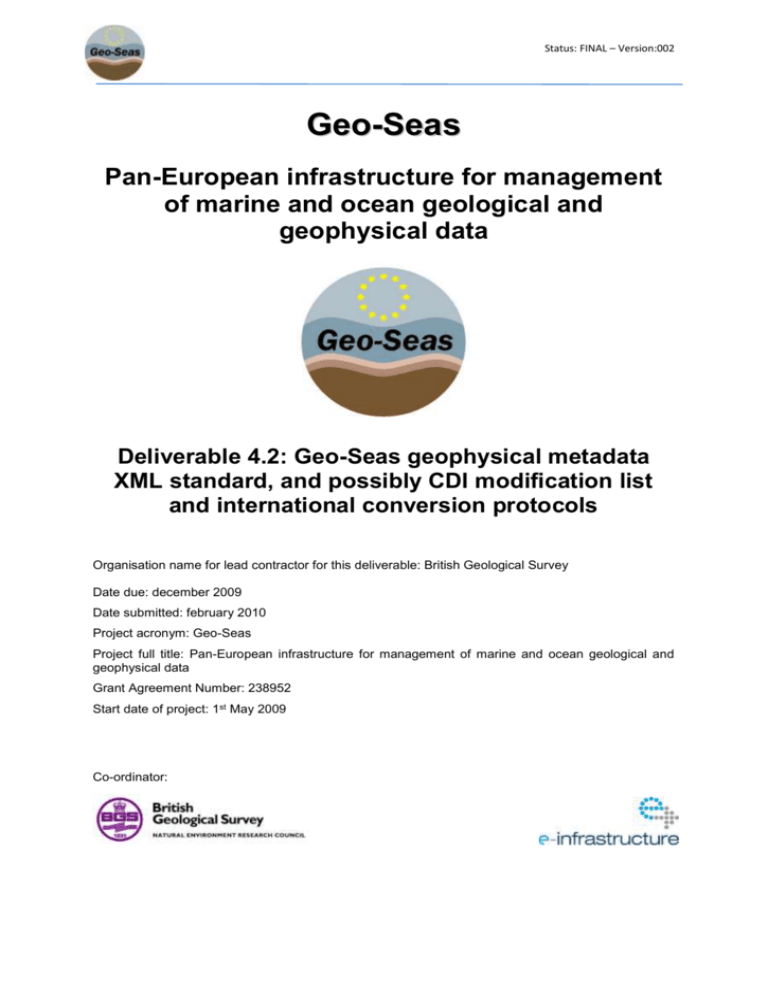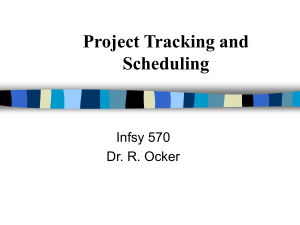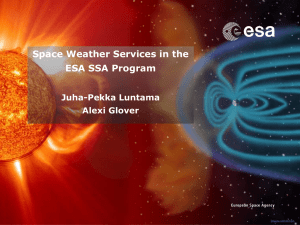document
advertisement

Status: FINAL – Version:002 Geo-Seas Pan-European infrastructure for management of marine and ocean geological and geophysical data Deliverable 4.2: Geo-Seas geophysical metadata XML standard, and possibly CDI modification list and international conversion protocols Organisation name for lead contractor for this deliverable: British Geological Survey Date due: december 2009 Date submitted: february 2010 Project acronym: Geo-Seas Project full title: Pan-European infrastructure for management of marine and ocean geological and geophysical data Grant Agreement Number: 238952 Start date of project: 1st May 2009 Co-ordinator: Status: FINAL – Version:002 Deliverable number Short Title 4.2 Geophysical extensions metadata standards and CDI Long Title Deliverable 4.2 – Geo-Seas geophysical metadata XML standard, and possibly CDI modification list and international conversion protocols Short Description Report on standards to be used within Geo-Seas while handling Geophisical data and the required extensions to the Common Data Index Keywords Geo-Seas geophysical metadata standards Authors / Organisation(s) Editor / Organisation Paolo Diviacco (OGS) Dick Schaap (MARIS) File name D4-2_GS_WP4_Geophysical-metadata-format_Final.doc Deliverable due date Deliverable submitted date December 2009 February 2010 Comments History Version Author(s) Status 001 P. Diviacco (OGS) Draft 002 D. Schaap (MARIS) Final Date Comments 25 february 2010 March 2010 Dissemination level PU Public CO Confidential, for project partners and the European Commission only D4.2 Geophysical Metadata Format X Status: FINAL – Version:002 Content 1 EXECUTIVE SUMMARY 2 XML STANDARDS AND CDI EXTENSIONS FOR GEOPHYSICS 2.1 INTRODUCTION 2.2 APPLIED APPROACH 3 DESCRIPTION OF SEADATANET STANDARDS 3.1 INTRODUCTION 3.2 CDI 3.3 VOCABULARIES 4 4.1 ANALYSIS OF SUITABILITY FOR GEOPHYSICS INTRODUCTION 4.2 Sampling Strategy in Seismics 4.3 Seismics products 4.4 Practices and legacies in Seismics 4.5 5 ANALYSIS CDI EXTENSIONS ADOPTED 5.1 GML objects 5.2 Service binding 5.3 Spatial and temporal resolution 6 O&M AND SENSORML EXTENSIONS 6.1 O&M section 6.2 SensorML sections 7 EXAMPLES OF METADATA D4.2 Geophysical Metadata Format Status: FINAL – Version:002 1 Executive Summary Geo-Seas is a sibling of the SeaDataNet initiative and will adopt its approach, architecture and middleware. On the other hand SeaDataNet was developed for the Oceanographic community, which means that the extension of the framework towards Geophysics and Geology needs some tailoring to fit the practices and traditions of a different research field. In this perspective Work package 4 was intended to develop content standards, profiles and common transport and service protocols and within WP4 task WP4.2 was intended to adapt the SeaDataNet metadata standard for indexing geophysical data. As from the DOW the deliverables follow this schema. The CDI is the SeaDataNet central discovery service. It enables users to have a detailed insight of the availability and geographic extent of marine data archived at the connected data centres. Following ISO 19115 specifications it reports on metadata (what, where, when, how, who) and serves also as a link to the delivery service The objectives of the WP4.2 were: To collaboratively develop a shared view in handling Geophysical data To analyze the metadata formats previously adopted by EUMarsin, EuroCore and EU-SEASED to highlight compatibilities and incompatibilites with the shared view To analyze other international initiatives in the field of Geophysics regarding practices and metadata standards To define the needed extensions to the CDI It was clear soon that, while for most of the Geophysical data types, as for example Gravimetric data or Magnetic data, most of the technologies already developed within SeaDataNet could be straightforwardly re-used, Seismic data need a specific consideration, and therefore specific CDI extension. On the other hand, it was highlighted also that extensions could pose a risk of speciation to the detriment of CDI ability to be a single tool that fits many data types. Therefore many efforts were spent defining a small core of extensions that all partners value as necessary to be added to the CDI and finding the correct place to accommodate the rest of tailoring in the vocabulary, transport format metadata and service binding to O&M and SensorML documents. After the discussion, the following extensions need to be added to the CDI: Extension of the CDI GML capabilities to handle ships tracks Addition of the possibility to handle multiple service bindings, for example to partners viewing facilities and to O&M documents describing parameters necessary to the end uses but that cannot be included into the CDI Addition of an element to account for spatial and temporal resolution CDI extensions are not sufficient since other issues, as Seismic line segmentation, link to external viewing services and domain specific browsing parameters are needed. These extensions will be moved towards external documents residing at each partner. A prototype of these extensions is described in details in section 6 of this document. The fundamental criteria adopted were: what pertains to data discovery is restricted to the CDI D4.2 Geophysical Metadata Format Status: FINAL – Version:002 what pertains to data access is hosted by the O&M document what pertains to domain specific parameters is hosted by the SensorML document CDI, O&M and SensorML documents are linked among them via URLs 2 XML standard and CDI extensions for Geophysics 2.1 Introduction The aim of the Geo-Seas EU project is to create a common data space for all the interconnected data centres of its partners where end users will be able to find Geological and Geophysical data to support their studies. The Geo-Seas project is a sibling of the SeaDataNet EU project, and aims at adopting, where possible, the philosophy and technical solutions there developed. These were the outcomes of a careful analysis of the SeaDataNet target research field, which was Oceanography. Porting the experience of SeaDataNet toward Geology and Geophysics requires studying the practices and traditions of different research fields. In fact each research community tends to evolve separately and to live within specific paradigms that result in different and concurrent vocabularies; for example the concept of a layer is different for a geophysicist and a geologist. Besides, the sampling strategies can differ from field to field and this has to be taken into account since this is reflected in defining what actually has to be shared. This document reports on what has been done regarding Geophysics. 2.2 Applied approach Porting the SeaDataNet experience towards Geophysics was performed with a threefold approach that considered extensions to: CDI Vocabularies Service binding to O&M documents This approach was mainly motivated by the need of securing a CDI that could be used for many data types while at the same time respecting the needs and peculiarities of all the data types to be considered. In this, since each partner could have different experiences and skills in the various data types, it was very important to reach a common view shared by all the partners contributing to the work package. To ease the creation of such a shared perspective, Work package partners met twice (meeting in Utrecht and Bruxelles) to agree on the overall view, and on the other hand, used a web based Computer Supported Collaborative Work (CSCW) toolkit called COLLA to reach consensus on all the details. This service, hosted by OGS, aimed at consolidating in one platform all information, files, documents and messaging shared by the partners of the Work package. The portal allows applying a graphical task map to identify thematic areas or issues to discuss, and to organize within each of them the information available and the relative discussion. D4.2 Geophysical Metadata Format Status: FINAL – Version:002 All the partners receive automatic notifications of the status of the system via e-mail. All documents are available to all the partners with file naming and versioning control. Snapshots from Colla can be seen in the figures below Figure 1 Snapshots form the Computer Supported Collaborative Work tool (COLLA) used within WP4 to create a shared view D4.2 Geophysical Metadata Format Status: FINAL – Version:002 3 Description of SeaDataNet standards 3.1 Introduction The SeaDataNet infrastructure comprises a network of 40 interconnected data centres and a central SeaDataNet portal. This provides users a unified and transparent overview of the metadata and controlled access to the large collections of data sets, that are managed at these data centres. As a basis for the SeaDataNet services, common standards have been defined for metadata and data formats, common vocabularies, quality flags, and quality control methods, based on international standards, such as ISO 19115, NetCDF (CF), ODV, and best practices from IOC and ICES.CDI 3.2 CDI The Common Data Index (CDI) was initiated in the Sea-Search project. As part of SeaDataNet it is being further developed and extended in data coverage to all SeaDataNet data centres. Its primary objective is to give users a highly detailed insight in the availability and geographical spread of marine data across the different data centres and institutes across Europe. The CDI provides an index (metadatabase) to individual data sets. Furthermore it paves the way to direct online data access by means of downloads and server side visualization. 3.3 Vocabularies The use of a common vocabulary in all metadatabase and data formats is an important prerequisite towards consistency and interoperability. The SeadataNet vocabulary is based upon the NERC dataGrid (NDG) vocabulary Web service. Vocabulary Estensions were handled by the Work Package 4.3. D4.2 Geophysical Metadata Format Status: FINAL – Version:002 4 Analysis of suitability for geophysics 4.1 Introduction As from the Utrecht and Bruxelles meeting it was decided to handle the following set of geophysical data: Gravimetry (tracking) Gravimetry (gridded) Magnetic (tracking) Magnetic (gridded) Bathymetry (tracking) Bathymetry (gridded+swath) Heat flow Seismics (scanned images) Seismics (digital data) Seismics (navigation) Side scan sonar With the addition of two data types that do not strictly pertain to Geophysics only Images Maps (data product) Soon it was clear (see minute of the Utrecht meeting) that most of the data types mentioned and the relative practices implied could be quite easily handled using the methods and technologies developed within SeaDatanet. This is due to a similar sampling strategy as that of most of the oceanography data. The Seismic data type is peculiar compared to that. This is up mainly to the sampling strategy adopted in this field and the kinds of products available. The discussion on Seismic data highlighted the need of a CDI field recording the resolution of data. This could be extended also to other data types especially for the case of bathymetric data. Resolution of the measurements in time or spatial domain (frequency or grid size) is an important parameter during data discovery, because it directly defines the extent of possible use of the data. 4.2 Sampling Strategy in Seismics In Seismics, traces are acquired that correspond to arrivals at one (single fold) or multiple (multi-channel) receivers of an acoustic wave originated in a source positioned at a variable distance to the receivers. Marine Seismics can be applied from structural to very high-resolution studies, upon changing the configuration of the acquisition device (source+streamer), the penetration capability of the source and the signal sampling. All these parameters are then important while discovering/browsing data one is interested in, depending on the target of his/her research. D4.2 Geophysical Metadata Format Status: FINAL – Version:002 Trace separation (distance between traces) limits the spatial resolution namely the dip of geological structures. The sampling frequency of the actual trace limits the temporal resolution that is the bandwidth of the signal. The source penetration and bandwidth limits the “depth” of possible targets 4.3 Seismics products In the case of multichannel seismics the basic data (field/pre-stack) is processed to statistically improve the S/N ratio through a summation (stack) of traces that produces a stacked section (post-stack). As from the Utrecht GeoSeas WP4 meeting it was decided that partners could share either pre-stack or post-stack data depending on their internal data access policy. Further processing can lead to other data products. Any classification of products implies the introduction of a specific vocabulary extension that will be requested to WP4.3. Many different processing products can be identified upon the processing sequence, while a complete classification of them is not really very relevant it is important to distinguish prestack and post-stack data since visualization facilities will be provided only in the second case. It could be important to distinguish a specific class of produces as “migrated” data, since this introduces an important distinction from the interpreter point of view. 4.4 Practices and legacies in Seismics In handling Seismic data type one has to consider the existing practices in this field and their timing in the perspective of technological evolution. This is particularly important for sharing “vintage” data as in the case of the SeiscanX project. a. Traditionally geo-referencing seismic data was not an easy task. Pre-stack receiver positioning has to be derived upon source position, projecting it backward on the streamer configuration. In multi-channel Seismics, trace position (what actually appears in a post-stack seismic section) is neither that of the source nor that of the receiver, but through the concept of CMP/CDP, roughly corresponds to a position in between the source and the receiver position. This lack of direct correspondence and the adjoining issue of binning led to the consolidated practice to report within the navigation files only the position of the vessel antenna, translated to the source position. This non-strict correspondence between traces and positions led to the use of two separate files: one for the navigation, and the other for the actual traces. The correspondence between the two is guaranteed by an index which must be common to both traces and positioning and that is generally the shot number, though sometimes cdp number is used. As from the Utrecht WP4 meeting it was decided within the GeoSeas project to prefer shot point indexing. b. Usually surveys gather several seismic lines but there’s no universal method to decide what is a single line and what makes of some lines a survey. Plus the same survey could happen to refer to different “funding” projects that could be used in naming seismic lines. c. “Vintage” data is usually available as paper sections that, as in the SeiscanX project, can be converted to a digital image file. The technologies existing in the ’60 and ’70 but also more recently did not allow to process easily long (geographically) seismic line within the same processing job, then, although referring to the same seismic line, often it was preferred to divide those in segments, and so to plot the final processed section. D4.2 Geophysical Metadata Format Status: FINAL – Version:002 d. Navigation tracks in the E&P industry are generally straight, so that often to describe them, the starting and ending points only can be sufficient. Seismic lines acquired by Research Centres/Universities have commonly tortuous tacks, which need to introduce “smart” decimation. e. Due to the fact that research centres/universities generally cannot afford to allocate personnel for Data management, there has never been a full awareness of the importance of metadata in seismic data management, which led to the fact that often a lot of very important parameters are not available. Paper sections, when not lacking plot labels at all, quite often report only the very essential settings and survey reports are generally very basic. f. 4.5 In the E&P industry protocols has been always very well developed, while in the field of research standards were bent to the needs of the moment, resulting often in inhomogeneous products. Analysis Considering the issues mentioned above several problems can be seen in the present version of the CDI that will need some tuning. At the same time, as already mentioned, it is very important to preserve the CDI from becoming a speciated metadata model, since it should continue to act as a tool that could be used to discover all the data types considered within GeoSeas but also SeaDataNet. In this perspective a lot of discussions in COLLA was devoted to agree on what should become part of discovery (and therefore extend the CDI) and what has to remain outside to be handled then else how. The outcomes of the discussion highlights that “discovery” (see section 5) is to be intended in a strict iso19115 sense: a tool that span multiple data types while data selection upon domain specific parameters can be referred to as “browsing” and should not enter the CDI. Browsing is intended to help user select on finer grain criteria the data they are interested in, through ranging parameters. In Seismic data these parameters are not only pertinent to the data itself but also to the acquisition system that recorded them. For example if users are interested in small scale phenomena it would be very important for them to have the possibility to exclude from the beginning, data recorded for crustal studies. This selection can be based for example on the length of the streamer and/or on the sampling interval of the traces, therefore it is important to provide the space for these parameters. The information needed for browsing is eligible for being handled as: (i) vocabulary categories (see D4.3) and external XML documents (see section 6) Separating discovery and browsing can be achieved linking two different documents, but unfortunately, the original version of the CDI did not allowed for this, therefore it was requested to add to CDI, service binding capabilities. Another point that complicates the situation is the current CDI philosophy of a 1 to 1 relationship between dataset and CDI instance. For example in the case of Seismics, as from the Utrecht meeting, it was decided that the 1 to 1 correspondence should be intended with the seismic line. As in the above section 4.4.b sometimes it could be difficult to state exactly to what a seismic line corresponds and plus as in 4.4.c often seismic lines are segmented in many files. Therefore this issue should be tackled through an external XML document, without overloading the CDI A very important limit recognised in the previous versions of the CDI, was the limit in handling ship track and polygons as for the needs of hydrographical surveys or seismics. D4.2 Geophysical Metadata Format Status: FINAL – Version:002 Especially for geophysical and bathymetric data, resolution of the measurements in time or spatial domain (frequency or grid size) is an important parameter during data discovery, because it directly defines the extent of possible use of the data. So far there’s no field in the CDI that consider this important parameter. A considerable work was spent in reviewing the Vocabulary used in SeaDataNet (see D4.3). In this revision several terms were added while several were redefined. For example in the view of having a classification of seismic data upon its possible usage, it was discussed to change the criteria that distinguished low resolution, high resolution etc from a bandwidth interval based approach to a sampling interval based approach, being this more technically correct, allowing exclusive range definitions, and respecting the common practices. 5 CDI extensions adopted 5.1 GML objects The CDI V1 XML format and associated Schema was extended with a GML object, which enables to detail the geospatial features of tracks and polygons in conformity with the real geographical coverage. This will enable to describe in CDI V1 format also hydrographic and seismic surveys. A ISO-OGC compliant format extension is proposed, while on the longer run it is recommended to follow the developments taking place in the SOS (Sensor Observation Service) initiative. See : http://www.opengeospatial.org/standards/sos http://schemas.opengis.net/sos/1.0.0/examples/ The extension to the CDI V1 metadata format is to add an extra element by which one can specify a MultiPoint (collection of points), MultiCurve (tracks) or MultiPolygon (surfaces) in ISO-OGC compliant GML-format, the GML Simple Features profile. This can be used next to the existing and mandatory bounding box element. The most suitable position for the GML-extension in the CDI V1 XML format is to include it under the <BoundPoly> element under //Metadata/dataIdInfo/dataExt/ geoEle. replacing the existing definition of <BoundPoly>. The element BoundPoly can contain either a collection of points, of tracks or of surfaces. It is not possible to mix MultiPoints, MultiCurves and MultiSurfaces. This is not seen as a problem, considering the fact that geographical features of observations in practice are not mixed. The GML format also allows for a name or description to be added to the geometries. <gml:name> and <gml:description> elements could be used to add name, descriptions and possibly other metadata for example to seismic tracks. 5.2 Service bindings Service bindings are links (urls) to online services that allow a user or machine to get more information on the data. Examples are a viewing service (online data viewer) or an OGC WMS service. The current CDI V1 format only allows one fixed url or service binding, i.e. a link to the central CDI portal website. Service binding become a key element to extent the possibilities of the CDI without distorting its mission. This approach will be used also to solve the 4.4.a issue. In fact the actual positioning of seismic data will be made available as an external P1/90 file residing at the data collector, and accessible through service binding. With this extension issues as 4.4.a, b and c can be tackled addressing service binding to an external resource or O&M document. The introduction of O&M within the CDI was suggested in the view of the integration with the OneGeology initiative that, In fact, embeds O&M. D4.2 Geophysical Metadata Format Status: FINAL – Version:002 It was therefore natural to extend the use of O&M to account for metadata that could not reside within the CDI. In this there will be further work to be done since this integration with GeoSciML was not considered in the original planning of the work. For the implementation of service bindings the ISO 19139 draft profile for CDI has been followed as closely as possible to allow a smooth transition in the future. In the ISO 19139 schema, service bindings are included under gmd:MD_Metadata /gmd:distributionInfo/gmd:MD_Distribution/gmd:transferOptions. The equivalent in CDI v1 is Metadata/distInfo/distTranOps. In the original CDI V1 format it is only allowed to include one online resource under distribution info (Metadata/distInfo/distTranOps), that points to the central CDI portal website and its data access mechanism. To support additional service bindings the original CDI V1 schema was adjusted to allow multiple occurences of distTranOps. The current CDI V1 format defines an element “orFunct” that defines the function of the resource. The current format however only allows the value “downloadRegistration” (from SDN Vocab list L071), reflecting that users can download data sets after registration with the SeaDataNet AAA services. To allow for service bindings to other resources other values from L071 can be applied, such as “URL”. 5.3 Spatial and temporal resolution Spatial and temporal resolution has been added as a new element gridRepInfo under Metadata/spatRepInfo, where it can be used as an alternative to the existing vectRepInfo. The domain names of the resolution are specified as “time” (temporal resolution) or “track” (spatial resolution). The resolution is defined by a floating point value and a unit from the common vocabulary list P061. As resolution information is not required, the element gridRepInfo is optional, but once included, all information under gridRepInfo is mandatory. 6 O&M and SensorML extensions As mentioned above, what cannot be handled using the CDI will need to be managed through external documents based on O&M and SensorML. Observations and Measurements (O&M) is an Open Geospatial Consortium standard which defines a conceptual schema and XML encoding for observations, and for features involved in sampling when making observations. SensorML is made of standard models and XML schemas for describing sensor systems and processes associates with sensor observations. Besides tackling the issues listed in the previous sections, Using O&M and SensorML has the advantage also to bridge GeoSeas with GeoSciMl that uses the same technologies. The main tasks of the O&M section should be to address the issue of seismic line segmentation and redirection of end users to viewing facilities, while the SensorML part should act as a domain specific information storage. This builds a framework as that in figure 1 where three layers can be identified: Discovery, handled through the CDI with the extensions mentioned in section 5 Data visualization and aggregation of segments of seismic lines and navigation, handled through O&M Browsing: handled through SensolrML that holding domain specific parameters should allow fine grained data selection D4.2 Geophysical Metadata Format Status: FINAL – Version:002 Figure 2 The framework to be used in Seismic data handling is based on a three layer approach. Discovery is granted by the CDI, Data access is handled by the O&M part, Browsing is handled by SensorML 6.1 O&M section The O&M section is intended to cover aspects related to an observation. The Feature of interest is the volume of the earth interested by the propagation of the seismic wavefield, The Sampling Feature is the Seismic line or seismic volume The Sampled feature should be a generic entity that should represent any possible geologic feature. In this a GeologicFeature term from GeoSciMl will be used Within this perspective, the O&M section addresses the following problems: 1. 2. 3. 4. Segmentation of seismic lines (multiple files for the same line) Provide a link to the SensorML file Provide a link to quick-view services Provide a link to P1/90 navigation Files 1) To tackle the problem of segmentation of Seismic lines GeoSeas will use multiple instances of the <sa:relatedObservation> element. A solution adopted also in GeoSciML. D4.2 Geophysical Metadata Format Status: FINAL – Version:002 2) Browsing parameters will be stored within a SensorMl document that will need to be referred to from within the O&M document itself. This can be done through the O&M procedure element as in Figure 3 3) Within the Result element a link could be established to a quick-view or high resolution viewing facility. Being this XML extension we are discussing resident at data owner side, it will be a duty of each partner to put a consistent link to an existing quick-view facility. 4) The sampling section of O&M propose a <sa:shape> element in which it is possible to include a <gml:linestring> with the full line track and/or an url to a server side P1/90 file Figure 3 Segments of Seismic lines can be referred to through the relatedObservation element Figure 4 Link to the SensorML document can be established through the O&M procedure element D4.2 Geophysical Metadata Format Status: FINAL – Version:002 . Figure 5 Link to visualization services can be established through the O&M result element Figure 6 A link to the P1/90 navigation file can be established within the shape O&M element D4.2 Geophysical Metadata Format Status: FINAL – Version:002 6.2 SensorML section Data browsing will need several domain specific parameters. SensorML specifications are divided in several groups, among which it is possible to find a Metadata one. This group is further divided in sections as follows: Characteristics contains most of domain specific browsing parameters Capabilities report on the top bandwidth and therefore resolution of data History : reports events occurred during acquisition, related to the data but occurred at the sensor level The Characteristics section of the Metadata group can be further divided in 4 areas which will gather similar information: 1. Overall infos: Seismic method, Dimensionality, Overall quality, Data type, 2. Source: Parameters regarding the Source 3. Streamer configuration: n channels, first chan last chan, first chan offset, last chan offset 4. Acquisition: Sampling, trace length… top bandwidth In the History section will be put an URL link to a possible location where to find additional (and optional) documents (scanned logs or pdf or else) regarding the history acquisition (event logs). This can be considered temporary since the perspective is to build a proper extension in SensorML to handle the history of the data. This is the place for integration between GeoSeas and the FP7 Eurofleets project, where it is planned to develop an automatic reporting tool called EARS (Eurofleets Automatic Reporting System) based on the same view. Figure 7 Schema of the structure of the SensorML extension document D4.2 Geophysical Metadata Format Status: FINAL – Version:002 (*) Lists can be implemented via the codeSpace tag, that as form the SWE docs allows to refine the value of the Term by referencing a dictionary or ontology that defines choices or rules for the value UOM refers to the BODC vocabulary P061 Parameters in red = mandatory Parameters in blue= recommended but not mandatory Parameters in green = optional <Characteristics> <Overall infos> seismicMethod List (*): dimensionality List (*): dataProduct List (*): reflection refraction 2D 3D 4D Field data - Single fold continuous profile Processed - Single fold continuous profile Field data -multi-fold Processed -multi-fold Stacked migrated Other (explanations in an external document linked to from the history section below) overallQuality List (*): 0 [unknown (none)] 1 [good (good)] 2 [fair (probably_good)] 3 [poor (probably_bad)] 4 [bad (bad)] </Overall infos> <Source> SourceType D4.2 Geophysical Metadata Format List (*): Boomer Air gun (single) Air gun (array) Sparker Flexichoc Flexotir Watergun Explosive wire or detonating Status: FINAL – Version:002 ShotDistance cord GI-gun, Aquapulse, Vaporchoc, single-bubble airgun [float] [uom=metres] this is the distance between two consecutive shot (it is assumed that this distance is constant) </Source> <Receiver Configuration> nChan [integer] firstChan [integer] lastChan [integer] firstChanOffset [float] [uom=metres] lastChanOffset [float] [uom=metres] </Receiver Configuration> <Acquisitor> samplingInterval [float][ uom = microsec, as in BODC vocab P61] SamplesPerTrace [integer] RecordingDelay [float] uom = microsec (recommended if exist) </Acquisitor> <Capabilities> topBandwidth List (*): up to 60 HZ up to 250 HZ up to 1000 HZ up to 2000 HZ higher than 2000 HZ </Capabilities> <History> This section could later contain infos from Eurofleets Documentation D4.2 Geophysical Metadata Format Temporal URL to an external document describing the history of the acquisition of the dataset. (logbook) Status: FINAL – Version:002 </History> 7 Examples of Metadata Example 1: CDI document for a Seismic section (please note that this was produced with a version of Mikado that did not incorporate the outcomes of this deliverable) <!-- Please Note values are for demonstrative purposes only --> <?xml version="1.0" encoding="UTF-8"?> <Metadata xmlns:xsi="http://www.w3.org/2001/XMLSchema-instance" xsi:noNamespaceSchemaLocation="http://www.seadatanet.org/validator/cdi/cdi_sdn_v1.3a_2.1.xsd" > <mdFileID>SDN:CDI:LOCAL:Linea_F76-02_01</mdFileID> <mdLang> <languageCode value="en" /> </mdLang> <mdChar> <CharSetCd value="utf8" /> </mdChar> <mdHrLv> <ScopeCd value="dataset" /> </mdHrLv> <mdHrLvName SDNIdent="SDN:L231:3:CDI" >Common Data Index record</mdHrLvName> <mdContact> <rpOrgName SDNIdent="SDN:EDMO::150" >Istituto Nazionale di Oceanografia e di Geofisica Sperimentale - OGS, Dipartimento per lo sviluppo delle RIcerche e delle tecnologie MArine</rpOrgName> <rpCntInfo> <cntPhone> <voiceNum></voiceNum> <faxNum></faxNum> </cntPhone> <cntAddress> <delPoint>Borgo Grotta Gigante 42/c</delPoint> <city>Sgonico (Trieste),</city> <adminArea></adminArea> <postCode>34010</postCode> <country>Italy</country> <eMailAdd></eMailAdd> </cntAddress> <cntOnLineRes> <linkage>http://www.ogs.trieste.it</linkage> </cntOnLineRes> </rpCntInfo> <role> <RoleCd value="author" /> </role> </mdContact> <mdDateSt>2010-01-28T11:14:47</mdDateSt> <spatRepInfo> <VectSpatRep> <geometObjs> <geoObjTyp> <GeoObjTypCd value="curve" /> </geoObjTyp> </geometObjs> </VectSpatRep> </spatRepInfo> <refSysInfo> <MdCoRefSys> <refSysID> <identAuth> <resTitle>SeaDataNet geographic co-ordinate reference frames</resTitle> <resAltTitle>L101</resAltTitle> <resRefDate> <refDate>2007-02-10T06:45:02</refDate> <refDateType> <DateTypCd value="revision" /> </refDateType> </resRefDate> <resEd>2</resEd> <citId>http://www.seadatanet.org/urnurl/</citId> </identAuth> <identCode SDNIdent="SDN:L101:2:4326" >World Geodetic System 84</identCode> </refSysID> </MdCoRefSys> </refSysInfo> <mdExtInfo> <extEleInfo> <extEleName>SDN:EDMO::</extEleName> <extEleDef>http://www.seadatanet.org/urnurl/</extEleDef> <eleDatatype> <DatatypeCd value="codelist" /> </eleDatatype> <extEleParEnt>SeaDataNet</extEleParEnt> <extEleSrc> <resTitle>European Directory of Marine Organisations</resTitle> <resAltTitle>EDMO</resAltTitle> <resRefDate> <refDate></refDate> <refDateType> <DateTypCd value="revision" /> </refDateType> D4.2 Geophysical Metadata Format Status: FINAL – Version:002 </resRefDate> <resEd></resEd> <citId>http://www.seadatanet.org/urnurl/</citId> </extEleSrc> </extEleInfo> <extEleInfo> <extEleName>SDN:L021:1:</extEleName> <extEleDef>http://www.seadatanet.org/urnurl/</extEleDef> <eleDatatype> <DatatypeCd value="codelist" /> </eleDatatype> <extEleParEnt>SeaDataNet</extEleParEnt> <extEleSrc> <resTitle>SeaDataNet Geospatial Feature Types</resTitle> <resAltTitle>L021</resAltTitle> <resRefDate> <refDate>2007-12-20T02:00:05</refDate> <refDateType> <DateTypCd value="revision" /> </refDateType> </resRefDate> <resEd>1</resEd> <citId>http://www.seadatanet.org/urnurl/</citId> </extEleSrc> </extEleInfo> <extEleInfo> <extEleName>SDN:L031:2:</extEleName> <extEleDef>http://www.seadatanet.org/urnurl/</extEleDef> <eleDatatype> <DatatypeCd value="codelist" /> </eleDatatype> <extEleParEnt>SeaDataNet</extEleParEnt> <extEleSrc> <resTitle>SeaDataNet Measurement Periodicity Classes</resTitle> <resAltTitle>L031</resAltTitle> <resRefDate> <refDate>2006-12-21T06:43:27</refDate> <refDateType> <DateTypCd value="revision" /> </refDateType> </resRefDate> <resEd>2</resEd> <citId>http://www.seadatanet.org/urnurl/</citId> </extEleSrc> </extEleInfo> <extEleInfo> <extEleName>SDN:L071:1:</extEleName> <extEleDef>http://www.seadatanet.org/urnurl/</extEleDef> <eleDatatype> <DatatypeCd value="codelist" /> </eleDatatype> <extEleParEnt>SeaDataNet</extEleParEnt> <extEleSrc> <resTitle>SeaDataNet data access mechanisms</resTitle> <resAltTitle>L071</resAltTitle> <resRefDate> <refDate>2007-02-16T16:59:36</refDate> <refDateType> <DateTypCd value="revision" /> </refDateType> </resRefDate> <resEd>1</resEd> <citId>http://www.seadatanet.org/urnurl/</citId> </extEleSrc> </extEleInfo> <extEleInfo> <extEleName>SDN:L081:2:</extEleName> <extEleDef>http://www.seadatanet.org/urnurl/</extEleDef> <eleDatatype> <DatatypeCd value="codelist" /> </eleDatatype> <extEleParEnt>SeaDataNet</extEleParEnt> <extEleSrc> <resTitle>SeaDataNet Data Access Restriction Policies</resTitle> <resAltTitle>L081</resAltTitle> <resRefDate> <refDate>2008-09-26T01:00:06</refDate> <refDateType> <DateTypCd value="revision" /> </refDateType> </resRefDate> <resEd>2</resEd> <citId>http://www.seadatanet.org/urnurl/</citId> </extEleSrc> </extEleInfo> <extEleInfo> <extEleName>SDN:L231:3:</extEleName> <extEleDef>http://www.seadatanet.org/urnurl/</extEleDef> <eleDatatype> <DatatypeCd value="codelist" /> </eleDatatype> <extEleParEnt>SeaDataNet</extEleParEnt> <extEleSrc> <resTitle>SeaDataNet metadata entities</resTitle> <resAltTitle>L231</resAltTitle> <resRefDate> <refDate>2008-06-03T01:00:05</refDate> <refDateType> <DateTypCd value="revision" /> </refDateType> </resRefDate> <resEd>3</resEd> D4.2 Geophysical Metadata Format Status: FINAL – Version:002 <citId>http://www.seadatanet.org/urnurl/</citId> </extEleSrc> </extEleInfo> <extEleInfo> <extEleName>SDN:L241:1:</extEleName> <extEleDef>http://www.seadatanet.org/urnurl/</extEleDef> <eleDatatype> <DatatypeCd value="codelist" /> </eleDatatype> <extEleParEnt>SeaDataNet</extEleParEnt> <extEleSrc> <resTitle>SeaDataNet data transport formats</resTitle> <resAltTitle>L241</resAltTitle> <resRefDate> <refDate>2007-09-15T01:00:03</refDate> <refDateType> <DateTypCd value="revision" /> </refDateType> </resRefDate> <resEd>1</resEd> <citId>http://www.seadatanet.org/urnurl/</citId> </extEleSrc> </extEleInfo> </mdExtInfo> <dataIdInfo> <idCitation> <resTitle>Linea_F76-02</resTitle> <resAltTitle>Linea_F76-02_01</resAltTitle> <resRefDate> <refDate>1967-01-01T00:00:00</refDate> <refDateType> <DateTypCd value="revision" /> </refDateType> </resRefDate> <citRespParty> <rpOrgName SDNIdent="SDN:EDMO::150" >Istituto Nazionale di Oceanografia e di Geofisica Sperimentale - OGS, Dipartimento per lo sviluppo delle RIcerche e delle tecnologie MArine</rpOrgName> <rpCntInfo> <cntPhone> <voiceNum></voiceNum> <faxNum></faxNum> </cntPhone> <cntAddress> <delPoint>Borgo Grotta Gigante 42/c</delPoint> <city>Sgonico (Trieste),</city> <adminArea></adminArea> <postCode>34010</postCode> <country>Italy</country> <eMailAdd></eMailAdd> </cntAddress> <cntOnLineRes> <linkage>http://www.ogs.trieste.it</linkage> </cntOnLineRes> </rpCntInfo> <role> <RoleCd value="originator" /> </role> </citRespParty> </idCitation> <idAbs>in case of SEG-Y data this can be extracted from Reel Header. In case of Scanned data (SEISCAN) very few infos are available</idAbs> <idPoC> <rpOrgName SDNIdent="SDN:EDMO::150" >Istituto Nazionale di Oceanografia e di Geofisica Sperimentale - OGS, Dipartimento per lo sviluppo delle RIcerche e delle tecnologie MArine</rpOrgName> <rpCntInfo> <cntPhone> <voiceNum></voiceNum> <faxNum></faxNum> </cntPhone> <cntAddress> <delPoint>Borgo Grotta Gigante 42/c</delPoint> <city>Sgonico (Trieste),</city> <adminArea></adminArea> <postCode>34010</postCode> <country>Italy</country> <eMailAdd></eMailAdd> </cntAddress> <cntOnLineRes> <linkage>http://www.ogs.trieste.it</linkage> </cntOnLineRes> </rpCntInfo> <role> <RoleCd value="custodian" /> </role> </idPoC> <descKeys> <keyword SDNIdent="SDN:P021:42:SRFL" >Seismic reflection</keyword> <keyTyp> <KeyTypCd value="parameter" /> </keyTyp> <thesaName> <resTitle>BODC Parameter Discovery Vocabulary</resTitle> <resAltTitle>P021</resAltTitle> <resRefDate> <refDate>2009-07-29T01:00:56</refDate> <refDateType> <DateTypCd value="revision" /> </refDateType> </resRefDate> <resEd>42</resEd> <citId>http://www.seadatanet.org/urnurl/</citId> </thesaName> D4.2 Geophysical Metadata Format Status: FINAL – Version:002 </descKeys> <descKeys> <keyword SDNIdent="SDN:L05:4:154" >multi-channel seismic reflection systems</keyword> <keyTyp> <KeyTypCd value="instrument" /> </keyTyp> <thesaName> <resTitle>SeaDataNet device categories</resTitle> <resAltTitle>L05</resAltTitle> <resRefDate> <refDate>2008-01-11T02:00:04</refDate> <refDateType> <DateTypCd value="revision" /> </refDateType> </resRefDate> <resEd>4</resEd> <citId>http://www.seadatanet.org/urnurl/</citId> </thesaName> </descKeys> <descKeys> <keyword SDNIdent="SDN:L061:7:31" >research vessel</keyword> <keyTyp> <KeyTypCd value="platform_class" /> </keyTyp> <thesaName> <resTitle>SeaDataNet Platform Classes</resTitle> <resAltTitle>L061</resAltTitle> <resRefDate> <refDate>2008-12-05T02:00:04</refDate> <refDateType> <DateTypCd value="revision" /> </refDateType> </resRefDate> <resEd>7</resEd> <citId>http://www.seadatanet.org/urnurl/</citId> </thesaName> </descKeys> <resConst> <LegConsts> <accessConsts SDNIdent="SDN:L081:2:LI" >licence</accessConsts> </LegConsts> </resConst> <aggrInfo> <aggrDSName> <resTitle>F76</resTitle> <resAltTitle>F76</resAltTitle> <resRefDate> <refDate>1976-01-01</refDate> <refDateType> <DateTypCd value="revision" /> </refDateType> </resRefDate> </aggrDSName> <assocType> <AscTypeCd value="largerWorkCitation" /> </assocType> <initType> <InitTypCd value="campaign" /> </initType> </aggrInfo> <dataScale> <scaleDist> <value> <Decimal></Decimal> </value> <uom> <UomTime> <uomName SDNIdent="SDN:L031:2:4" >hour to sub-day</uomName> <conversionToISOstandarUnit></conversionToISOstandarUnit> </UomTime> </uom> </scaleDist> </dataScale> <dataLang> <languageCode value="en" /> </dataLang> <tpCat> <TopicCatCd value="oceans" /> </tpCat> <dataExt> <geoEle> <GeoBndBox> <westBL>16.1789417</westBL> <eastBL>17.198167</eastBL> <southBL>41.999556</southBL> <northBL>42.155</northBL> </GeoBndBox> </geoEle> </dataExt> <dataExt> <tempEle> <TempExtent> <exTemp> <TM_GeometricPrimitive> <TM_Period> <begin>1976-01-01T00:00:00</begin> <end>1976-01-01T00:00:00</end> </TM_Period> </TM_GeometricPrimitive> </exTemp> </TempExtent> </tempEle> D4.2 Geophysical Metadata Format Status: FINAL – Version:002 </dataExt> <dataExt> <vertEle> <vertMinVal>0</vertMinVal> <vertMaxVal>10</vertMaxVal> <vertUoM> <uomName>metres</uomName> <conversionToISOstandarUnit></conversionToISOstandarUnit> </vertUoM> <vertDatum> <datumId> <identAuth> <resTitle>Vertical Co-ordinate Reference System Origins</resTitle> <resAltTitle>L111</resAltTitle> <resRefDate> <refDate>2009-04-29T01:00:03</refDate> <refDateType> <DateTypCd value="revision" /> </refDateType> </resRefDate> <resEd>6</resEd> <citId>http://www.seadatanet.org/urnurl/</citId> </identAuth> <identCode SDNIdent="SDN:L111:6:D08" >sea level</identCode> </datumId> </vertDatum> <vertLimit>10</vertLimit> </vertEle> </dataExt> </dataIdInfo> <distInfo> <distributor> <distorCont> <rpOrgName SDNIdent="SDN:EDMO::150" >Istituto Nazionale di Oceanografia e di Geofisica Sperimentale - OGS, Dipartimento per lo sviluppo delle RIcerche e delle tecnologie MArine</rpOrgName> <rpCntInfo> <cntPhone> <voiceNum></voiceNum> <faxNum></faxNum> </cntPhone> <cntAddress> <delPoint>Borgo Grotta Gigante 42/c</delPoint> <city>Sgonico (Trieste),</city> <adminArea></adminArea> <postCode>34010</postCode> <country>Italy</country> <eMailAdd></eMailAdd> </cntAddress> <cntOnLineRes> <linkage>http://www.ogs.trieste.it</linkage> </cntOnLineRes> </rpCntInfo> <role> <RoleCd value="distributor" /> </role> </distorCont> <distorFormat> <formatName SDNIdent="SDN:L241:1:CF" >Climate and Forecast NetCDF</formatName> <formatVer>1</formatVer> </distorFormat> </distributor> <distTranOps> <onLineSrc> <linkage>http://www.sdn-taskmanager.org/</linkage> <orDesc></orDesc> <orFunct> <OnFunctCd value="downloadRegistration" /> </orFunct> </onLineSrc> </distTranOps> </distInfo> </Metadata> D4.2 Geophysical Metadata Format Status: FINAL – Version:002 Example 2: O&M document for a Seismic section, e.g.: file IT89AP103_om.xml <?xml version="1.0" encoding="UTF-8"?> <sa:SamplingCurve xmlns:sml="http://www.opengis.net/sensorML/1.0.1" xmlns:gml="http://www.opengis.net/gml" xmlns:sa="http://www.opengis.net/sampling/1.0" xmlns:om="http://www.opengis.net/om/1.0" xmlns:xlink="http://www.w3.org/1999/xlink" xmlns:xsi="http://www.w3.org/2001/XMLSchema-instance" xsi:schemaLocation="http://www.opengis.net/om/1.0 http://schemas.opengis.net/om/1.0.0/om.xsd http://www.opengis.net/sensorML/1.0.1 http://schemas.opengis.net/sensorML/1.0.1/sensorML.xsd http://www.opengis.net/sampling/1.0 http://schemas.opengis.net/sampling/1.0.0/sampling.xsd"> <!-- Please Note values are for demonstrative purposes only --> <gml:description> Seismic line </gml:description> <gml:name>IT89AP103</gml:name> <gml:boundedBy> <gml:Envelope srsName="urn:ogc:def:crs:EPSG::4979"> <!-- reference system for geodetic non projected seismic tracks --> <gml:lowerCorner>-30.7117 134.2053</gml:lowerCorner> <gml:upperCorner>-30.7111 134.2059</gml:upperCorner> </gml:Envelope> </gml:boundedBy> <sa:sampledFeature xlink:href="urn:cgi:featureType:CGI:GeoSciML:2.0:GeologicFeature"/> <sa:relatedObservation > <om:Observation gml:id="IT89AP103_s1"> <gml:description>First segment of IT89AP103 seismic line</gml:description> <om:samplingTime> <gml:TimeInstant> <gml:timePosition>2007-06-06T17:20:30.00+08:00</gml:timePosition> </gml:TimeInstant> </om:samplingTime> <om:procedure xlink:href="http://sismica.ogs.trieste.it/sensor/IT89AP103_sml.xml" /> <!—- this is the link to the SensorML file --> <om:observedProperty xlink:href="http://bodc.somewhere/definitions/amplitude" /> <om:featureOfInterest xlink:href="http://bodc.somewhere/definitions/earthVolume" /> <om:result xlink:href="http://sismica.ogs.trieste.it/viewer?CDI_ID=..SEZ_ID= IT89AP103_s1" xlink:role="application/sgy" xsi:type="gml:ReferenceType" /> <!—- this is the link to the viewing service --> </om:Observation> </sa:relatedObservation> <sa:relatedObservation> <om:Observation gml:id=" IT89AP103_s2"> <gml:description>Second segment of IT89AP103 seismic line</gml:description> <om:samplingTime> <gml:TimeInstant> <gml:timePosition>2007-06-06T17:20:30.00+08:00</gml:timePosition> </gml:TimeInstant> </om:samplingTime> <om:procedure xlink:href="http://sismica.ogs.trieste.it/sensor/IT89AP103_sml.xml" /> <om:observedProperty xlink:href="http://bodc.somewhere/definitions/amplitude" /> <om:featureOfInterest xlink:href="http://bodc.somewhere/definitions/earthVolume" /> <om:result xlink:href="http://sismica.ogs.trieste.it/viewer?CDI_ID=..SEZ_ID=IT89AP103_s1" xlink:role="application/sgy" xsi:type="gml:ReferenceType" /> </om:Observation> </sa:relatedObservation> <sa:shape xlink:href="http://sismica.ogs.trieste.it/viewer?CDI_ID=..NAV_ID=navigation_sism_1"> <!—-link to P1/90 file --> <gml:LineString gml:id="IT89AP103_segmentA" srsName="urn:ogc:def:crs:EPSG:6.8:4329"> <gml:pos>-30.711 134.205 321.</gml:pos> <gml:pos>-30.710 134.204 315.</gml:pos> <gml:pos>-30.709 134.203 303.</gml:pos> </gml:LineString> </sa:shape> </sa:SamplingCurve> D4.2 Geophysical Metadata Format Status: FINAL – Version:002 Example 3: SensorML document for a Seismic section, e.g: IT89AP103_sml.xml (please note that this document is possibly linked from multiple O&M relatedObservation sections) <?xml version="1.0" encoding="UTF-8"?> <sml:SensorML xmlns:sml="http://www.opengis.net/sensorML/1.0.1" xmlns:swe="http://www.opengis.net/swe/1.0.1" xmlns:gml="http://www.opengis.net/gml" xmlns:xlink="http://www.w3.org/1999/xlink" xmlns:xsi="http://www.w3.org/2001/XMLSchema-instance" xsi:schemaLocation="http://www.opengis.net/sensorML/1.0.1 http://schemas.opengis.net/sensorML/1.0.1/sensorML.xsd" version="1.0.1" > <sml:member> <sml:ProcessModel gml:id="SEISMIC_LINE_ACQUISITION"> <!-- METADATA SECTION --> <gml:description>....</gml:description> <!-- INPUTS DEFINITION --> <sml:inputs> <sml:InputList> <sml:input name=""> <swe:DataRecord> <swe:field name="Characteristics"> <swe:DataRecord> <swe:field name="OverallInfos"> <swe:DataRecord> <swe:field name="SeismicMethod"> <swe:Category> <swe:codeSpace xlink:href="http://bodc.somewhere/definitions/seismicMethod" /> <swe:value>reflection</swe:value> </swe:Category> </swe:field> <swe:field name="Dimensionality"> <swe:Category> <swe:codeSpace xlink:href="http://bodc.somewhere/definitions/dimensionality" /> <swe:value>2D</swe:value> </swe:Category> </swe:field> <swe:field name="DataProduct"> <swe:Category> <swe:codeSpace xlink:href="http://bodc.somewhere/definitions/productType" /> <swe:value>stacked</swe:value> </swe:Category> </swe:field> <swe:field name="OverallQuality"> <swe:Category> <swe:codeSpace xlink:href="http://bodc.somewhere/definitions/overallQuality" /> <swe:value>good</swe:value> </swe:Category> </swe:field> </swe:DataRecord> </swe:field> <swe:field name="Source"> <swe:DataRecord> <swe:field name="SourceType"> <swe:Category> <swe:codeSpace xlink:href="http://bodc.somewhere/definitions/sourceType" /> <swe:value>boomer</swe:value> </swe:Category> </swe:field> <swe:field name="ShotDistance"> <swe:Quantity> <swe:uom code="m" /> <swe:value>25</swe:value> </swe:Quantity> </swe:field> </swe:DataRecord> </swe:field> <swe:field name="ReceiverConfiguration"> <swe:DataRecord> <swe:field name="NChan"> <swe:Quantity> <swe:uom code="m" /> <swe:value>1</swe:value> </swe:Quantity> </swe:field> <swe:field name="FirstChan"> <swe:Quantity> <swe:uom code="m" /> <swe:value>1</swe:value> </swe:Quantity> </swe:field> <swe:field name="LastChan"> <swe:Quantity> <swe:uom code="m" /> <swe:value>120</swe:value> </swe:Quantity> </swe:field> <swe:field name="FirstChanOffset"> <swe:Quantity> <swe:uom code="m" /> <swe:value>500</swe:value> </swe:Quantity> </swe:field> <swe:field name="LastChanOffset"> <swe:Quantity> D4.2 Geophysical Metadata Format Status: FINAL – Version:002 <swe:uom code="m" /> <swe:value>3500</swe:value> </swe:Quantity> </swe:field> </swe:DataRecord> </swe:field> <swe:field name="Acquisitor"> <swe:DataRecord> <swe:field name="SamplingInterval"> <swe:Quantity> <swe:uom code="microseconds" /> <swe:value>4</swe:value> </swe:Quantity> </swe:field> <swe:field name="SamplesPerTrace"> <swe:Quantity> <swe:uom code="m" /> <swe:value>1024</swe:value> </swe:Quantity> </swe:field> </swe:DataRecord> </swe:field> </swe:DataRecord> </swe:field> <swe:field name="Capabilities"> <swe:DataRecord> <swe:field name = "TopBandwidth"> <swe:Category> <swe:codeSpace xlink:href="http://bodc.somewhere/topBandWidth" /> <swe:value>up to 250 HZ</swe:value> </swe:Category> </swe:field> </swe:DataRecord> </swe:field> <swe:field name="History"> <swe:Category> <swe:codeSpace xlink:href="http://ogs.somewhere/documentation" /> </swe:Category> </swe:field> </swe:DataRecord> </sml:input> </sml:InputList> </sml:inputs> <sml:method xlink:href="urn:ogc:def:process:SeismicLineAcquisition:1.0" /> </sml:ProcessModel> </sml:member> </sml:SensorML> D4.2 Geophysical Metadata Format Status: FINAL – Version:002 D4.2 Geophysical Metadata Format







